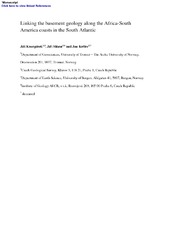Linking the basement geology along the Africa-South America coasts in the South Atlantic
Peer reviewed, Journal article
Accepted version

Åpne
Permanent lenke
https://hdl.handle.net/1956/15728Utgivelsesdato
2016-07Metadata
Vis full innførselSamlinger
- Department of Earth Science [1034]
Originalversjon
https://doi.org/10.1016/j.precamres.2016.05.011Sammendrag
The match of geological units of the dissected Kaoko-Dom Feliciano-Gariep orogenic system exposed along the coasts of the South Atlantic is poorly understood. Two suites of intrusive rocks crop out in the Angra Fria Bay area, a part of the Coastal Terrane of the Kaoko Belt in Namibia. U–Pb zircon dating of three samples from the younger suite provided ages of 574 ± 6, 586 ± 3 and 584 ± 7 Ma, similar to the ages of the oldest syn-collisional granitoids in the area. Three samples of the older suite gave ages of 626 ± 5, 622 ± 5 and 620 ± 6 Ma respectively, which have not previously been recorded in intrusive rocks of the Kaoko Belt, but which coincide with those from the Florianópolis Batholith in the Dom Feliciano Belt in Brazil. Zircon ages, Sr–Nd isotopic composition and tectonic position of these granitoids suggest that this magmatic complex could be a continuation of the Florianópolis Batholith on the African side of the Atlantic Ocean. Consequently, the Angra Fria intrusions and the Florianópolis Batholith may represent suitable localities for spatial reconstruction of the Gondwana supercontinent in the area, where the robust pre-Mesozoic connecting points are scarce.